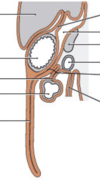8.1: The Peritoneum and Peritoneal Cavity Flashcards


the ___ lines tha bdominopelvic cavity. what’re the two layers of this structure?
peritoneum. Has parietal and visceral layers
the intraperitoneal organs are enclosed by the ___ layer of the peritoneum, and are suspended by ____
enclosed by the visceral layer, and are suspended by mesenteries
what is a mesentery
double layers of peritoneum that attach to the body wall– basically contexts the parietal and visceral peritoneum
describe the location of primarily retroperitoneal structures
posterior to the peritoneal cavity, are not suspended by a mesentery, and are covered by peritoneum only on their anterior surface.
describe the locations of secondarily retroperitoneal structures
structures were previously intraperitoneal structures that became fixed to the posterior abdominal wall when their mesentery fused with the parietal peritoneum of the posterior abdominal wall during development.
describe the positioning of the subperitoneal structures
include pelvic organs that lie below the peritoneum.
Organs associated with the gastrointestinal tract are ____ or ______. Organs of the urinary system are _____.
Organs associated with the gastrointestinal tract are intraperitoneal or secondarily retroperitoneal. Organs of the urinary system are retroperitoneal.


which organs are suspended by mesentery and are completely covered by the peritoneum?
INTRAPERITONEAL ORGANS
Stomach
Small intestine (jejunum, ileum, some of the superior part of the duodenum THE DUODENUM IS MAINLY SECONDARILY RETROPERITONEAL)
Spleen
Liver (with the exception of the bare area)
Gallbladder
Cecum with vermiform appendix (portions of variable size may be retroperitoneal)
Large intestine (transverse and sigmoid colons)
which organs are primarily retroperitoenal?
kidneys, suprarenal glands
which organs are secondarily retroperitoneal?
recall: SR structures were previously intraperitoneal structures that became fixed to the posterior abdominal wall when their mesentery fused with the parietal peritoneum of the posterior abdominal wall during developmenet.
these structures include:
how many layers is a mesentery? Function?
mesentery is a double layer of peritoneum that connects intraperitoneal organs to the posterior abdomianl wall and transmits vessels and nerves.
3 major mesenteries of the abdomen
The mesentery of the small intestine: suspends the second and third parts (jejunum and ileum) of the small intestine.
The _transverse mesocolo_n suspends the transverse section of the large intestine.
The sigmoid mesocolon suspends the sigmoid colon of the large intestine in the left lower quadrant.
how many layers is an omentum and what is its function
omentum is a double layer of peritoneum that connects the stomach and duodenum to another organ.
the greater omentum is a ____ layered apron of peritoneum that drapes ____, anterior to the coils of the small intestine, beofre looping upwards to its distal attachment on the posterior ___ wall
the greater omentum is a FOUR layered apron of peritoneum that drapes INFERIORLY, anterior to the coils of the small intestine, beofre looping upwards to its distal attachment on the posterior POSTERIOR ABDOMINAL wall
the ____ ligament is a portion of the greater omentum that adheres to the transverse colon, whereas the ___ ligmaent is. alteral extension of the greater omentum that connects the stomach to the spleen and is traversed by branches of the splenic artery
the GASTROCOLIC ligament is a portion of the greater omentum that adheres to the transverse colon, whereas the GASTROSPLENIC ligmaent is lateral extension of the greater omentum that connects the stomach to the spleen and is traversed by branches of the splenic artery
the lesser omentum is a ___ layer of peritoneum that extendsd from the ____ to the ____ and proximal ____. it is formed by the ____ and the _____ ligaments
the lesser omentum is a DOUBLE layer of peritoneum that extendsd from the LIVER to the STOMACH (INNER CURVATURE) and proximal DUODENUM. it is formed by the HEPATOGASTRIC and the HEPATODUODENAL ligaments
locations of the hepatogastric and hepatoduodenal ligamnet
the hepatogastric ligament, between the liver and stomach, and
the hepatoduodenal ligament, between the liver and duodenum, which encloses the structures of the portal triad (the portal vein, hepatic artery, and bile duct) in its free edge.



















